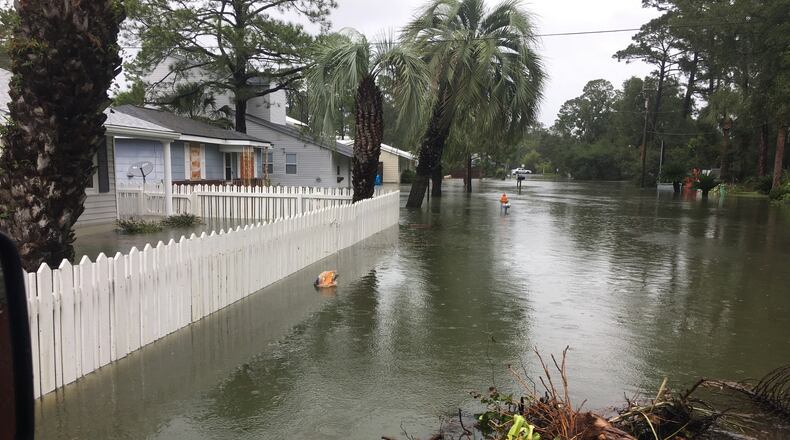The cost of climate change is difficult to calculate, but a new study by the activist organization the Center for Climate Integrity proposes a base-line figure.
The center conducted a study that looked at protecting coastal communities from the expected rise in sea levels over the next 20 years.
In the state of Georgia, that price tag will be more than $15 billion, according to the study.
Nationwide, the cost will be $400 billion, said executive director Richard Wiles. “That is approaching the money we spent on the entire interstate highway system,” he said, “and we would have to do it in half the time.”
Partnering with the engineering firm Resilient Analytics and geographic information system specialists at the University of Colorado, the center calculated the cost of constructing seawalls to contain the rising water, using “conservative” estimates of sea level increases
"We looked at a short-term, modest sea level rise by the year 2040, not a worst-case scenario, not far in the future,"
said Wiles. "We did this to determine what needs to be done now, not in the future."
Wiles and his colleagues discussed the results of the study in a teleconference Wednesday afternoon, the same day that the Trump administration adopted new rules rolling back limits on carbon emissions.
The new policies at the Environmental Protection Agency remove Obama-era efforts to combat climate change.
“Today’s action represents the final nail in the coffin for federal climate policy in the U.S.” said Wiles.
The “bare minimum” solution proposed by the center would build sea walls in areas of any infrastructure -- generally, any area that includes a road.
In Georgia that would mean 2,400 miles of seawall, or essentially the whole coast, plus walls in some estuaries and other areas.
Participating in the teleconference was Skip Stiles, executive director of the Norfolk, Va.-based Wetlands Watch, who said “It’s a lowball estimate of our adaptation costs.”
Some coastal geologists questioned the idea of building seawalls along an entire coastline. "Seawalls are not the environmentally preferred option for protecting the shoreline," said Clark Alexander, director of the University of Georgia Skidaway Institute of Oceanography.
He added that in some Georgia counties “the cost to protect them is going to outstrip the value of what you’re protecting. “
The answer for some of these counties, he said, will be "managed retreat." Communities will fall back and let the sea gobble up whatever is there. "Honestly, managed retreat is the only way to deal with this issue in the long term."
On the other hand, he said, using seawall construction as a common measure for all coastal communities is a “first step to trying to get some sort of unambiguous level playing field to look at what it’s going to cost around the U.S.”
Sea level rise isn’t consistent from place to place for a variety of reasons.
On the west coast the movement of tectonic plates is lifting the coast slightly, which keeps sea level rise lower, said C.J. Jackson, associate professor of geology at Georgia Southern.
On the Atlantic, by contrast, the coast has been sinking over time, said Jackson, so the ocean is rising faster. Sverre Leroy, the Center for Climate Integrity’s lead analyst, said Georgia should expect a rise of two to three feet by the year 2100.
Wiles acknowledged that “armored” coastlines can be detrimental to the migrations of salmon and whales. Solutions that allow those migrations will likely be even more expensive, he said.
“In every case we’ve looked at, the current estimate by city planners has been greater than ours,” he said. Even “managed retreat” will be more expensive, he said, because of compensation for abandoned properties.
Who will pay for these protections?
“Everyone points to the federal government, but the federal government may not be able to build the life raft that we hope to see,” said Stiles. “The U.S. Corps of Engineers has $90 billion in projects lined up, but only gets about $3 billion a year in appropriations.”
The Center for Climate Integrity believes that oil and gas companies should pay a significant percentage, and supports “meritorious” court cases against fossil fuel companies.
“They were well aware that climate change was occurring,” said Wiles. “Fifty years ago scientists were warning them of catastrophic outcomes right around this time in the future. Instead of diversifying they ran a 30-year campaign of denial.”
Should oil companies pay? Perhaps, said Alexander. But the rest of us are also on the hook. “The science community has been telling the public for 20 years now, ‘here’s what’s happening, here’s what’s going to happen.’ We are, in some ways, complicit in this.”
About the Author
Keep Reading
The Latest
Featured




